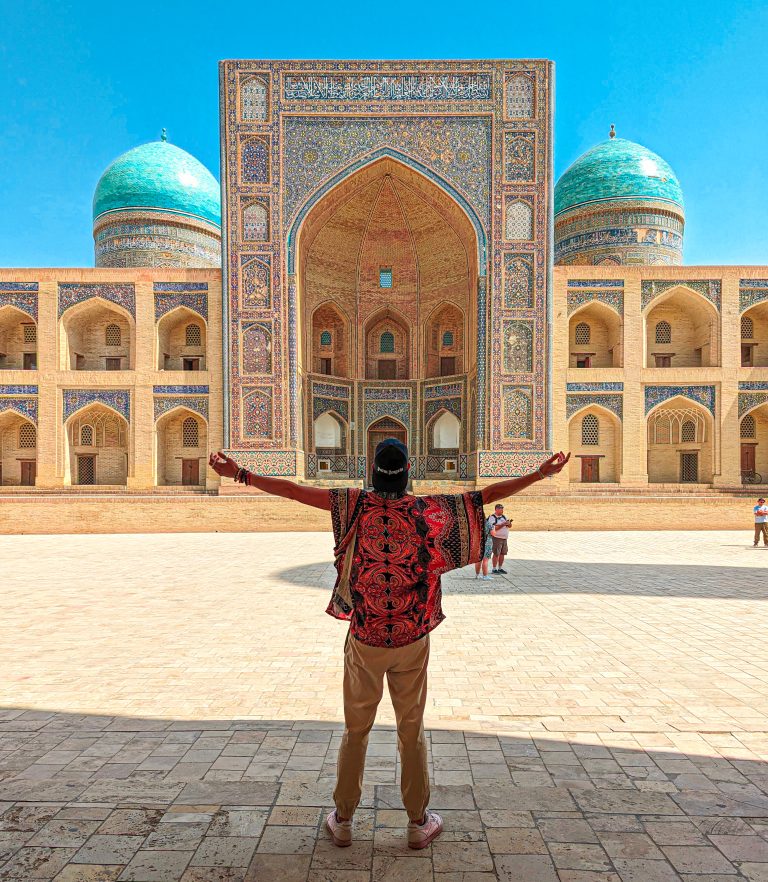Ultimate backpacking guide for Vietnam
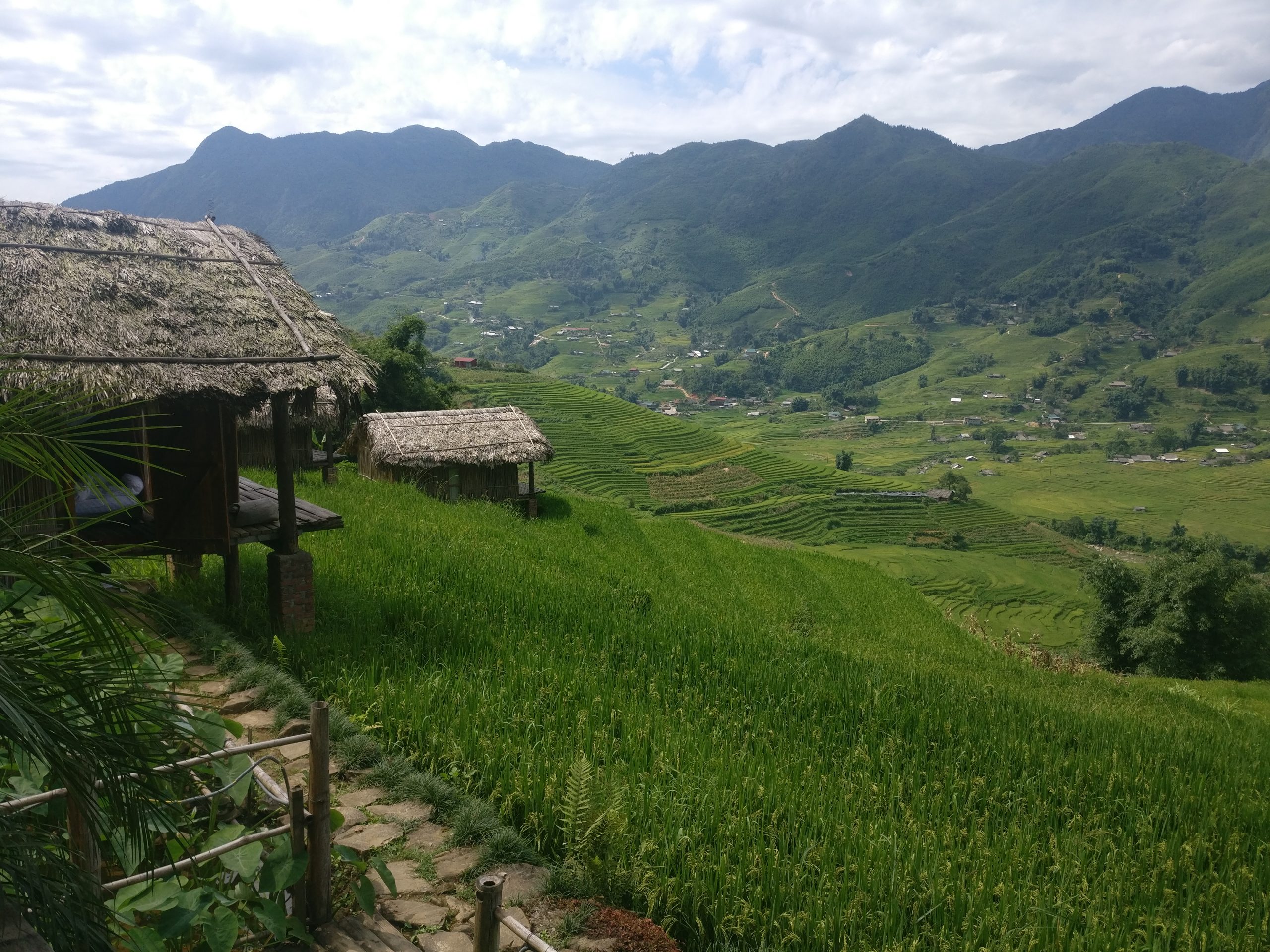
Vietnam is a country that you do not expect. Probably before considering Vietnam as your next destination, you knew practically nothing about it or what it was hiding. It’s what happened to me. In fact, I bought the tickets first and then I found out what could be done in Vietnam. Why not? What will sound like the most to you is the Vietnam war with the United States. But his visit will not leave you indifferent, rice fields lowered by the mountains, imperial fortresses and one of the most imposing natural wonders, Ha Long Bay.
The definitive guide to Vietnam, everything you need to know for your trip:
- Best time of year to visit Vietnam
- Basic tips for Vietnam
- 15-day itinerary for backpacking Vietnam
- Daily budget backpacking Vietnam
- Where to stay in Vietnam
- What to do in Vietnam if you have more time
Official exchange rate 1EUR = 25,000 VND (Vietnamese dong), you will feel like a true millionaire, since as soon as you spend it will cost you all hundreds of thousands of dongs.
Best time of year to visit Vietnam
The first thing you should know is that like many countries if you want to visit them in their entirety there is no better or worse time to get to know them in their entirety. What scared me the most was that every time I looked at the weather app it told me that it was going to rain. Well far from reality. Yes it is true is that when it rains, it will rain as if there were no tomorrow and the sky will break over you, but they are usually tropical rains and although intense, they are not very long. On the other hand, what better than a little rain to overcome the embarrassment that characterizes South-East Asia?
- May to August: It is when the southern area receives its monsoons, it is the best time to visit the north of the country.
- December to February: The northern area receives the winter monsoon and you will find more frequent rains including possible floods in some areas of Sapa.
If you want to visit the country in its entirety, the most convenient thing would be from March to April and September to November, which is when the weather is usually more neutral. In my case, I visited Vietnam in August and I had very good weather even though it rained multiple times.
Best tips for traveling to Vietnam
Here are some basic tips, although obvious in some cases, but it should be remembered to be clear.
- Cross the streets of Ho Chi Minh (you would never have imagined advice like this): For vehicles at traffic lights, there is only one color, GREEN. They don’t stop, but the traffic flows on its own without any accidents. The first time you have to cross a street you will see that nobody stops for you. Get moving and you will see that like Moses in the Red Sea the vehicles begin to avoid you.
- Exchange houses: It is relatively regulated and exchange houses take little commission, you can withdraw money at the HCMC airport with the same change as in any other part of the city.
- Motorcycle rental: I would not recommend renting a motorcycle in HCMC or Hanoi under any circumstances, but it is definitely something you have to do in Hoi An and Ninh Binh. It is the best way to get to the most remote places without tourists. You don’t need to have a license, just know how to drive them.
- Water: Always drink bottled water and make sure that the ice in your drink is made of drinking water (ask)
- Grab: Forget about the taxi, the best way to get around Vietnam is Grab, you know what you pay from the first minute and the app works great since understanding you in English with them can be somewhat complicated.
15-day itinerary for backpacking Vietnam
You are probably wondering how to design your route through Vietnam. You’re in luck, you have two options! from south to north or north to south, and now I will detail what from my point of view you can not miss.
- Sapa valley
- Ha Long Bay
- Hanoi
- Tam Coc (Ninh Binh)
- Hoi an
- Hué
- Mekong Delta and Ho Chi Minh
These were the priorities when setting up the trip. Many people do Na Trang but there was not enough time. The trip is divided into three parts:
- South area (Ho Chi Minh and Mekong Delta)
- Central area (Hue, Hoi An and Da Nang)
- North area (Hanoi, SaPa, Ha Long Bay and Tam Coc)
If you go with the right time, there will be things in Vietnam that you will not be able to do without a tour! But don’t abuse!
Day 1: Ho Chi Minh
After a long 30 hours to get to Vietnam we spent a little rest at the hotel before going out to kick all HCMC. With our batteries charged and Lonely Planet in hand, we went out in search of a tour so that the next day it would take us to the Mekong Delta 600,000 dongs (€ 35 / pax).
It is advisable to hire tours in Vietnam, if you do it from home it will cost you much more expensive than negotiating it on site with the agencies.
To all this the universal flood catches us and we have to take refuge with twenty other Vietnamese in the awning in front of a store until the storm subsided. In Vietnam in the period that we were, the storms are characterized by being short but intense. When the storm subsided we ended up having dinner at some street stalls in Ben Thanh market for just 100,000 dong.
Days 2 and 3: Mekong Delta
We got up early with our batteries recharged from the previous day’s flight and went to breakfast. As I said, there are two ways to visit Vietnam with and without a tour, unfortunately the Mekong delta is too big an area to travel on your own without wasting much time (although with 1 day you have plenty).
“Peter” or that’s what westerners called him, he picked us up at 8am in a minibus. When we say minibus we mean mini in every way, small seats, small legroom, small trunk etc … Which may be very good for an Asian as they are small but for a European you can already imagine how comfortable they are. It can be a 4h trip like that. To make matters worse, the last ones picked us up and they gave us even smaller seats, imagine the faces of the Vietnamese when at the first technical stop we gave them the change of seats.
As far as the Mekong delta is concerned, we were a bit sad to have to visit it in this way, since in two days they try to fill your time as best they can and you end up seeing completely unnecessary things. What you cannot miss is the Sampan Boat ride, the floating market and touring the delta by boat. The rest, poultry farm, rice noodle manufacturing process, folk dances and sugar cane products factory (from scarves, nightgowns and body creams to toothbrushes) with demonstration included, are a bit unnecessary. We will end up spending the night in Can Tho, a city 4 hours from HCMC with nothing to see.



At the end of the second day, our friend Peter dropped us off at HCMC at around 4 in the afternoon so it gave us time to see what we had to do in the city. Notre Dame Cathedral, Post Office, Ho Chi Minh Statue, Ben Tanh Market, Reunification Palace and Independence Palace. Although the downside is that many public buildings cannot be entered.
We were very surprised by one aspect of HCMC and it is that we suddenly went down a street and it seemed that we were in New York, a totally new street with a lot of skyscrapers, luxury hotels and Starbucks on every corner. But do not worry since it is the exception that confirms the rule since when you move away a couple of streets you return to the bustling Ho Chi Minh, where you have to watch so that you do not get run over when crossing the green traffic light, where you find a stand of Phó food every two meters and groups of Vietnamese sitting on their stools doing nothing.
Day 4: Hué
The good starts!
Save time for this chapter! We lacked days in Hoi An and Hue to do it thoroughly. Are you afraid of motorcycles? I hope not! 100% Recommended to rent a motorcycle between both cities with drop off at the destination and with transfer of backpacks. We went from Hue to Hoi An (a little expensive 580,000 dong / motorcycle, the reverse route is half price …)
Our flight arrived at 2 in the afternoon at Da Nang airport as we had no time to lose and our driver from Grab did not show up we decided to take a taxi to Hue.
In this case, the bad luck of arriving late to Hué turned into quite a surprise, since we were very lucky that the Forbidden City 150,000 dong was open at night. It is a must in every rule and even better if you can visit it at night, with practically no tourists. We had the venue practically to ourselves, the temperature was very pleasant, the lighting at night gave it an aura of mystery and all this was accompanied by different shows in each area of the Forbidden City.


The best way to get to the Forbidden City is by crossing the Rio Perfume and continuing towards the citadel of Hué.
I recommend dining on the backpacker street there is a lot of atmosphere and local restaurants.
Day 5: Motorbike trip from Hué to Hoi An
The next day we got up early as a 150km scooter route awaited us. Tip: Sun cream, especially the driver.
The route is simply incredible, the best moment without a doubt. Along the route you can stop at waterfalls, pagodas, fishing beaches, small villages and get away from the masses of tourists. When you rent the motorcycle they will tell you the best places to stop.






We had to cross Hai Van Pass, a mountain pass along the coast with incredible views, on the other side of the mountain, Da Nang, the great city in the center of the country, awaited us. In Da Nang it is worth stopping at the Linh Ung Pagoda but what you cannot miss are the Marble Mountains 40,000 dong; a rock formation four mountains in the middle of Da Nang city with caves and temples, we were lucky that it started to rain and we had the enclosure to ourselves. For the remainder of the day, a universal flood accompanied us to Hoi An, while the motor of the motorcycle stopped every two by three due to the rain.
Day 6: Hoi An
Yes, Hoi An is the city of lanterns and made-to-measure suits / dresses, they make one for you on request for the same day. But beyond this, Hoi An is getting lost in its streets, its little shops, markets and little bridges across the river. During the night the magic arrives as tourists and locals gather near the river to release lanterns with wishes for the current to carry them away. There are also a lot of cute restaurants with terraces near the river.
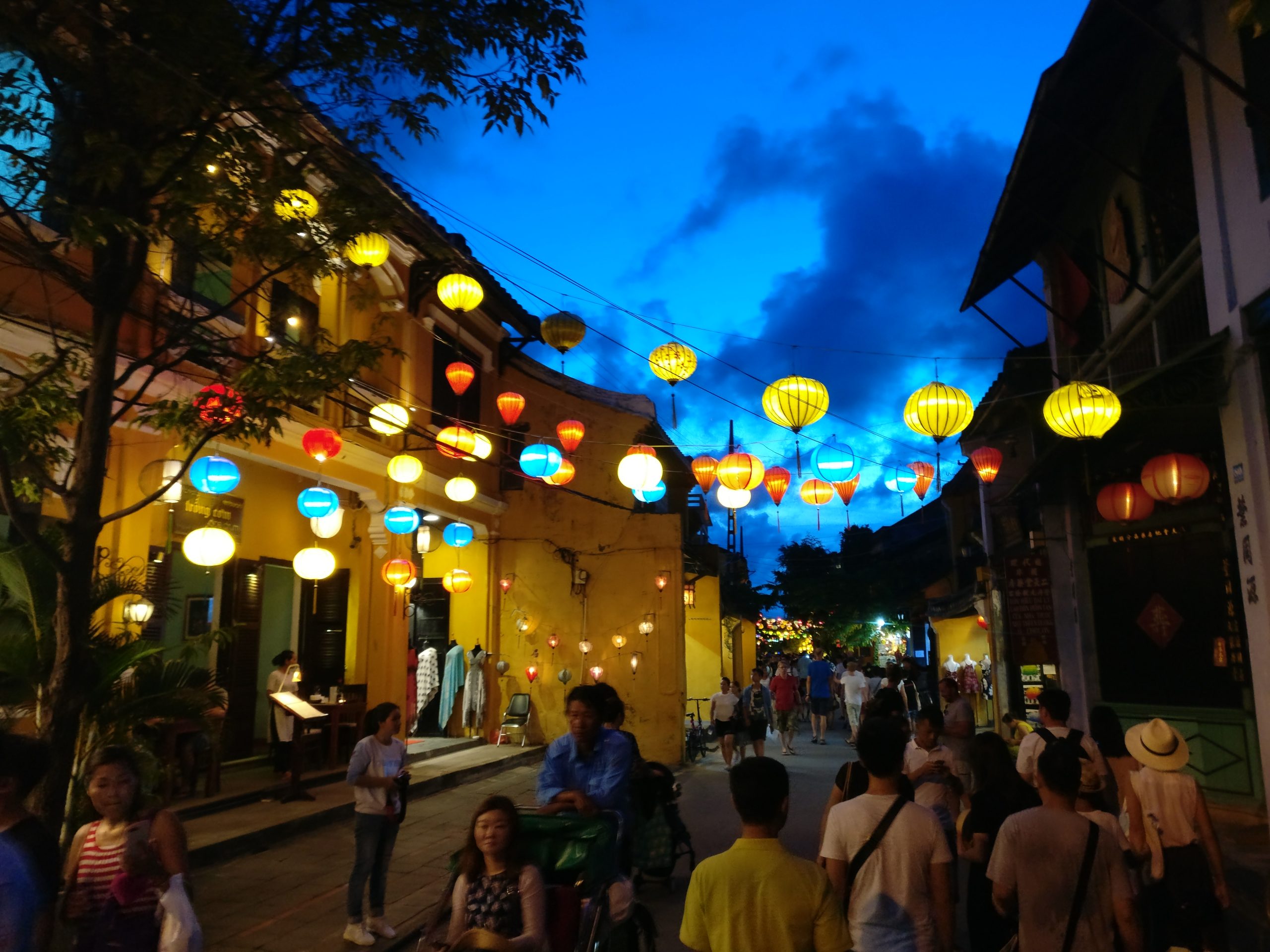
Day 7 and 8: Hanoi
It is very easy to lose a lot of time in transport in this area so beware of how you ride the route in the northern part of the country.
We used Hanoi as a hub and from there we went to our destinations with the help of Sara and Hue, the endearing receptionists of the Serene Hotel in Hanoi. Very nice but a bit heavy, from here we send you a hug and five stars in TA!
Hanoi is many things, pagodas, Ho Chi Minh mausoleums and Catholic style cathedrals. But above all Hanoi is the old district, what chaos !.
From the airport you can take bus 7 or 17 indistinctly that for 15,000 dong will take you to the city center from Noi Bai airport, the journey takes about 40 minutes.
Once in Hanoi we dedicated ourselves to touring the old quarter, in itself it does not have any cultural attraction, but it is Vietnam at its best. There you will find Vietnamese people cooking Pho Bo in any corner, people sitting on the mini stools doing nothing, streets organized by trade, fake shops, hairdressers in the middle of the street, improvised markets etc … We recommend seeing the Cha Dong Xuan market Dong Kiem Lake, Ngoc Son Pagoda and Saint Joseph Cathedral. We took with us as a memory two Vietnamese schoolchildren of about 6 or 7 years old who were learning English and they came to ask us questions for some homework. (L)
The next day, this time with a little more tranquility, we got up slowly and went to the Ho Chi Minh Mausoleum (watch out for the schedules). Can you imagine a esplanade with concrete and marble buildings at 40º degrees in the shade? Yes? Now imagine that with long pants and long sleeves, the authorities did not allow us to enter with bare limbs, so we had to get hot. In the same enclosure we could see the pagoda of the only pillar. After recharging the batteries and eating we went to the temple of literature for us, one of the most top in Hanoi.
At daybreak we met for a few beers with some friends from Barcelona who were also in Hanoi to share experiences, at least we hadn’t slept with cockroaches or rats; what we take =). At about 9 o’clock we went to the hotel to look for our backpacks to catch the 500,000 dong y / v sleeping bus that would take us to Lao Cai (Sapa Valley)
Days 9 and 10: Sapa Valley
After six hours of rattling we woke up in Lao Cai. There the H’Mongs were waiting for us, who in exchange for money would offer you accommodation in their house and trekking through the mountains. We look for accommodation for our part Eco Palms House a dream cabin in the middle of the rice fields and we look for a trekking on our own in the city with a 700,000 dong H’Mong guide for two people.
Mama Mao explained to us everything she knew about Sapa, she took us through the villages, roads and rice fields for almost 7 hours. The experience was fantastic. The H’Mong have received virtually no education and have learned English by listening to tourists speak. We were so tired that we fell asleep at 9 at night.


The next day we took it easier and went walking on our own for 3 or 4 hours until the storm caught us, the only strong one we would have every day. The storm lasted all afternoon, which we spent playing cards and board games until we caught the bus back to Hanoi in the evening.
The sleeping bus is the best way to move efficiently around Vietnam without wasting time and making the most of your days. That’s right the rattle and noises are not suitable for everyone.
Days 11 and 12: Ha Long Bay Cruise
The bus dropped us off in Hanoi at dawn, where we waited in the hotel lobby until the Ha Long Bay mini bus came to pick us up (100EUR / 2D1N Superior Room with Stellar Cruise). On this excursion it is worth scratching your pocket a bit and you can do it in advance to ensure a good boat, since the cheapest ones are from many years ago and there are rats and cockroaches.
Ha Long Bay, is one of the 7 wonders of nature. Legend has it that long ago, when their ancestors were at war, the gods of the sky sent a family of dragons to help defend their lands. This family of dragons descended on what is now Ha Long Bay and began to spit out jewels and jade. Upon colliding with the sea, these jewels became the different islands and islets that dot the seascape and formed a formidable fortress (and maze of islands) against the invaders.
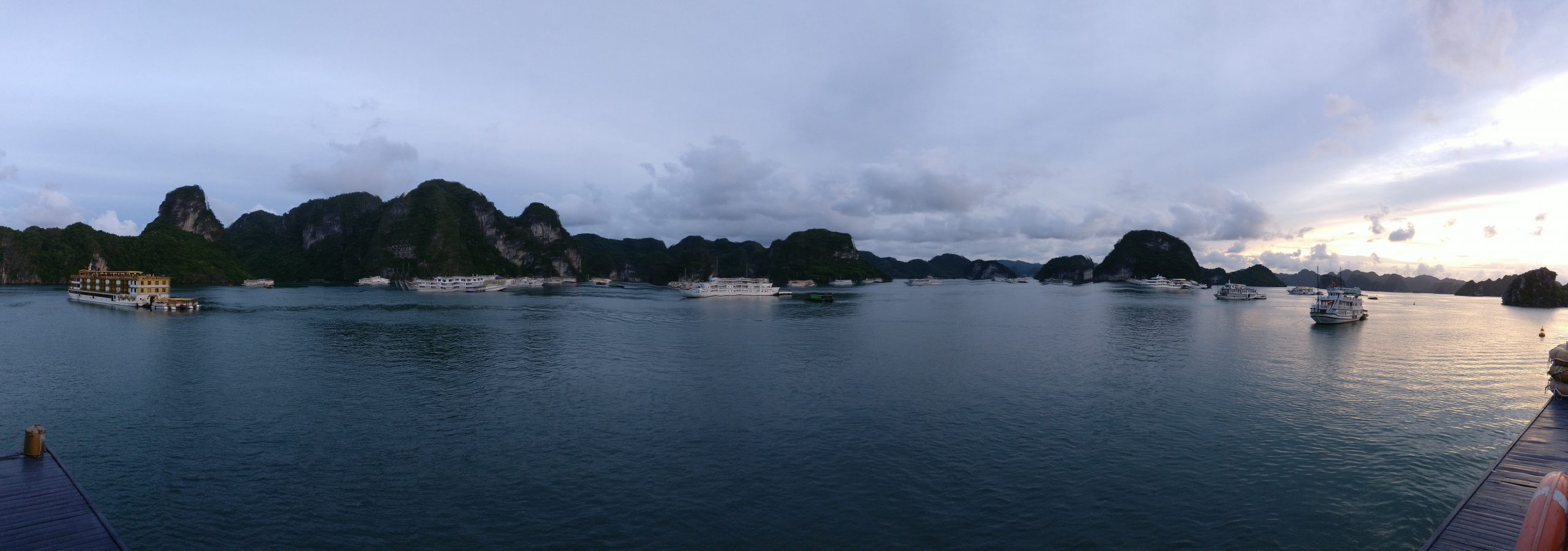
From the first moment everything was great, the cruise began to sail between the islands, the views were incredible, the further you got into the bay the more beautiful the landscape was. During the two days of the cruise we visited some caves, we stopped at a couple of islands to go trekking and we went up to a viewpoint at the top of one of these islands. We even went for a canoe ride through the interior of an island that you could only access by a very low pass from the sea. At dusk there was a party on the deck of the ship where we met with the rest of the cruise companions to have some drinks.
Many people stay one more day in Ha Long Bay to visit Cat Ba Island, we did not do it because we decided to prioritize the next day in Tam Coc and we were not wrong.
Day 13: Tam Coc (Ninh Binh)
We got up early and headed to the Hanoi train station to go to Tam Coc. Tam Coc is also known as the Halong Bay of the land, it is south of Hanoi. To go to Tam Coc you have to take a train at Hanoi station and stop at Ninh Binh, there were trains almost every two hours in the morning and we took one back at 6pm. The one-way ticket cost us very cheap 70,000 dongs / person and in comfortable armchair-type seats, on our return by mistake we bought cheaper tickets € 65,000 / person and we had to swallow 2 hours on a wooden bench, they did not let us pay the difference to change category … quite an experience.





In Ninh Binh we rented a motorcycle for 125,000 dong, we were touring the entire natural park. There are many people who rent a boat trip on the rivers, but we consider it too “touristy” and we began to improvise on the roads, discovering what we wanted at will. We were very surprised and we loved it. You cannot miss the Mua Caves 100,000 dong, a 500-step climb to the top of a mountain from where the views are exceptional.
Days 14 and 15: Hanoi and back to Ho Chi Minh
The following days we spent touring Hanoi to do last minute purchases and some souvenirs, we took our backpacks to go to the airport and return to HCMC since our plane back to Barcelona was leaving from there.
Daily budget backpacking Vietnam
Keep in mind that both in the Mekong delta, Sapa and Ha Long we had the food included in the price for which we acquired the activities and / or guides. Leaving this point aside you can eat perfectly streetfood for € 6-7 a day or in restaurants for about € 12. In our case we were alternating and we got a very good average.
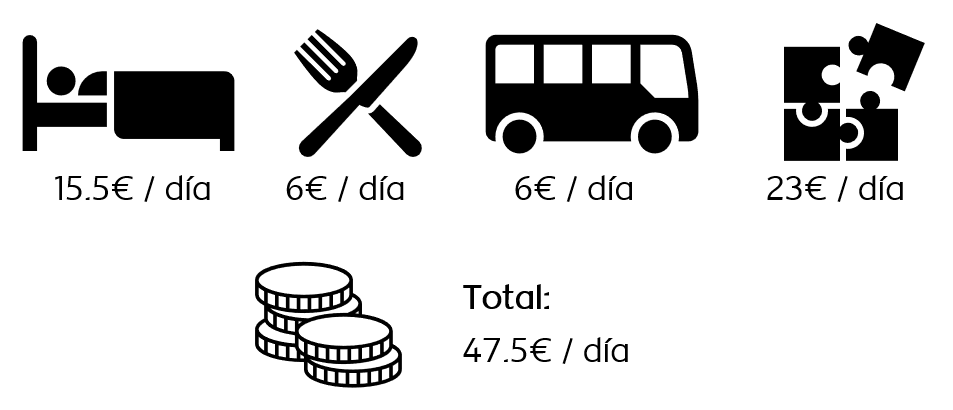
Also say that Vietnam is ideal for backpacking, it is full of hostels and a lot of places with a lot of atmosphere. You can find hostels for about € 5 a day, just make sure the reviews and that they are well located. Withdraw cash for free with N26. If you don’t have an N26 card register and earn 25€ of free credit.
Where to stay in Vietnam
These are the best places to stay, don’t miss the last one and book it in advance!
- Asian Ruby Select Hotel // Ho Chi Minh: We were there the first two days and we repeated on the way back to take the plane to Barcelona. Buffet breakfast on a great rooftop, very well located in the center of HCMC, excellent value for money.
- Villa of tranquility // Hoi An: It is a villa, 10 minutes by bike from the center, they will leave their bicycles for free, it has a swimming pool and it is very quiet. Very large and clean rooms.
- Serene Boutique Hotel & Spa // Hanoi: We stayed a total of three nights on our comings and goings between Sapa, Halong and Tam Coc, the girls at the reception were lovely and the rooms were spotless.
- Eco Palms // Sapa: The jewel of the trip in terms of accommodation, well above the average price for the area, but it is an eco lodge with 5 bungalows literally hanging from the mountain. The views are magical, you will wake up to the mist over the rice fields and to the sound of nature.


What to do in Vietnam if you have more days
I hope I have convinced you and that you enjoy the trip. Personally, the only thing that I would change is to have been a little less in the Mekong Delta and to have changed it for a day in Cu Chi tunnels (inform you well and be careful with the touristy ones !!!) or a day in the park of Phong Nha Ke Bang , the rest was great.
- Cuchi Tunnels: It is an extensive system of interconnected tunnels. During the Vietnam War, an additional 200 kilometers were built by the Vietnamese socialists as the Vietcong base of operations for the Tet offensive carried out in 1968. The tunnels extend 40 km north of the central city.
- Phong Nha Ke Bang: It is a National Park, declared a World Heritage Site by UNESCO. It houses about 300 caves, of which only 20 have been explored. However, these data are provisional, since in recent years more caves have been discovered than previously thought.


